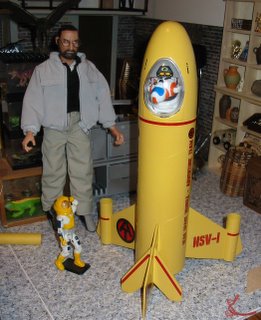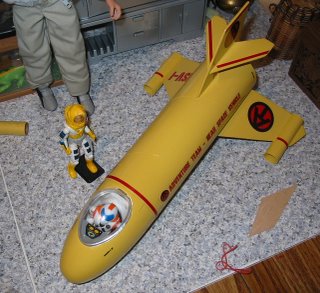Moving on to more pleasant matters, there's been some discussion over on the Sandbox about the idea of building a Joe launcher to loft parachute Joes to high altitudes. All sorts of systems have been proposed, but a lot of bandwidth has gone to the idea of strapping rockets to a Joe in some fashion.
I've tried to caution folks that this isn't nearly as easy as it might seem to the casual observer. First, Joe is a heavy (as model rockets go) and draggy object. You've got to come up with some way to make him fly straight, and come up with some way to deploy the parachute and you've got to do it while keeping it all light enough to fly (and to avoid the legal complications that going over 16 ounces of total weight will cause, Google "FAR 101" and "rocket" for details).
But this is a very attractive idea. I long ago decided that flying a 12" Joe was beyond both my current technical abilities and budget, so a couple years ago I decided to try my hand at launching something in the 3 3/4" Joe format. This is the result, the Adventure Team Near Space Vehicle (NSV-1).

This is modification of the Estes "Fat Boy" rocket kit. I chose it because it had sufficient diameter to put a small Joe inside in a seated position, and frankly, because you could get them cheaply at Wal-Mart at the time.
The original rocket had three identical fins. To these I added the tip extensions, pods (empty tubes) and horizontal stabilizers to increase the fin area (at it turned out, I didn't increase it quite enough, but more on that in a later post) and make it look more "X-Plane" like.

The cockpit was created by cutting a hole in the existing nose cone (blow-molded plastic) and attaching half of a plastic Easter-egg as a canopy. The seat is made from scrap foam, and the control panel from sheet plastic. Making the canopy latch securely (I had to hold the astronaut inside during boost, parachute deployment, and landing) while still being easily removable was actually a lot harder than it sounded. I ended up with a long tab in the back, and a short one in the front. Squeezing the nose side-to-side elongates the hold JUST enough to carefully snap the forward tab out and remove the canopy.
The other major modification was to the engine mount. The stock Fat Boy is designed for 18mm (A-C designation) motors. I changed the mount at accept the more powerful 24mm (D) motors. This was my main reason for the larger fins. The larger, heavier, motor would shift the center-of-gravity to the rear, making the rocket less stable. The astronaut in the front would counter-balance that somewhat, but I was still concerned (justifiably, as it happens). The 18mm motors could still be used with an adapter, and I always intended to use a smaller motor for the initial test flights.
The figure in the cockpit isn't actually a Joe, it's a Lanard "Star Corps" figure, a Joe knock-off. These figures were sold by the gazillions at Wal-Mart a while back, are easy to find in thrift stores, and not worth much to collectors. But I like the looks of them, and that made one an idea "cannon fodder" test pilot. I even super-glued tiny Adventure Team symbols to his space-suit.

The guy in the yellow space-suit was initially supposed to be my pilot. I found him in a thrift store too, but he's "Payload," the version packed only with the monster "Defiant Space Shuttle" GI Joe playset, and worth, as I discovered, a fair-chunk of change. I decided not to risk him on early flights (and at is turns out, that big helmet is too large to fit in my cockpit anyway!).
Yes, it did fly, and I have photos to prove it. I also later replaced my Star Corps pilot with a "real" Joe astronaut, as I'll show in a future post. Stay tuned.
No comments:
Post a Comment